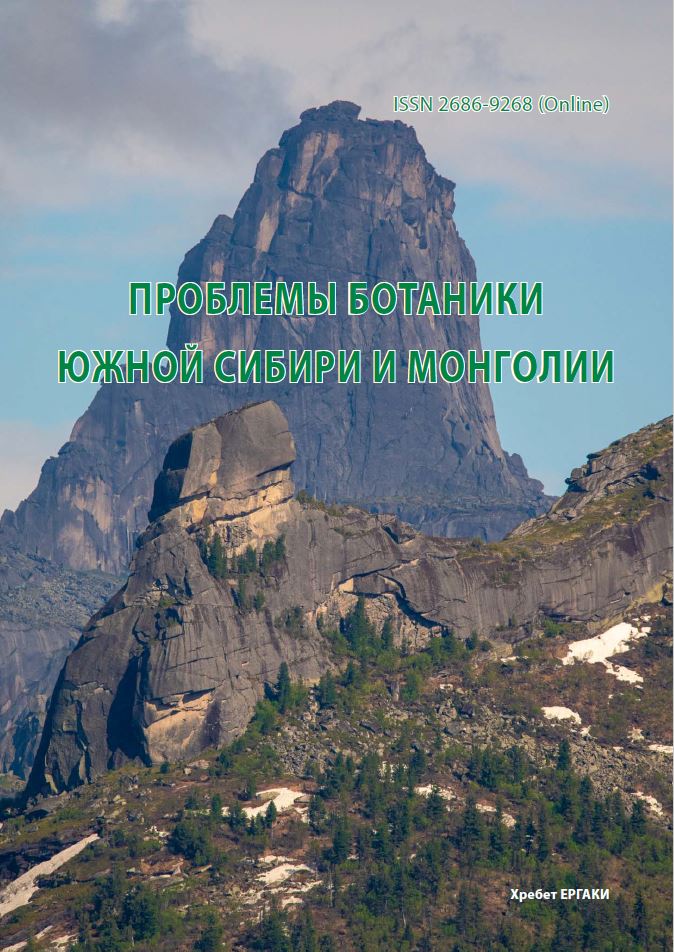Morphometry of the medicinal species Ajania fastigiata (structure features)
УДК 582.998.2:581.41+58.087
Abstract
The Asian genus Ajania Poljakov comprises about 30-40 species. Because of its complex taxonomic history with numerous movements of species between the two main groups of Artemisiinae Less., Ajania and individual genera are a particularly interesting group to study. Ajania cover most of the entire distribution range in Central Asia, with most in China, Korea, Japan and the Far East. The purpose of this research work is to clarify the morphological features of Ajania fastigiata (C. Winkl.) Poljakov, diagnostic features of vegetative organs of medicinal plants, which improves the quality of selection of raw materials for use in pharmacology. The material for the study was collected in September 2022. Morphometric data and macro-images were taken using a Levenhuk DTX RC3 remote-controlled microscope. The morphometric features were measured using “ImageJ” software The basic features were based on data from “Flora of Kazakhstan” and ‘Central Asian Explorer”. As a result of analysis of morphometric data Ajania fastigiata for Trans-Ili Alatau determined diagnostic features of vegetative organs of medicinal plants, which can improve the quality of selection of raw materials for use in pharmacology: height from 30 to 110 cm, but in most cases 50-80 cm; stem in the middle part 1.3-1.5 mm; width of septate leaves 0.7-1.0 mm; diameter of the basket 3.5-3.7 mm, stem of the basket 0.6-0.7 mm; diameter of the lower part of the tubular flower 0.5 mm, upper part 0.7 mm.
Downloads
Metrics
References
Ахметова С. Б. Противовоспалительное и ранозаживляющее азуленсодержащее эфирное масло Ajania fruticulosa (Ledeb.) Poljak. // Химия, технология и медицинские аспекты природных соединений. - Алматы, 2007. -С. 25-36.
Байтенов М. С. Ajania Poljakov // Флора Казахстана. Родовой комплекс флоры. - Алматы, 2001. - Т. 2. - С. 215.
Ковалевская С. С. Ajania fastigiatа // Определитель растений Средней Азии. АН РУ - Ташкент: Изд-во «Фан» Академии наук, 1993. - Т. 10. - С. 590.
Мулдашев А. А. Критический пересмотр рода Ajania (Asteraceae - Anthemideae) // Бот. журн., 1983а. - T. 68. -С. 584-588.
Мулдашев А. А. Монография рода Ajania Poljakov (Asteraceae - Anthemideae): Автореф. дис. ... канд. биол. наук. - Л., 1983б. - 16 с.
Поляков П. П. Два новых рода сем. Сложноцветных // Ботанические материалы Гербария Ботанического института им. В. Л. Комарова Академии наук СССР, 1955. - Т. 17. - С. 418-431.
Смагулов М. К. Влияние эфирного масла аянии на микрофлору гнойной раны в эксперименте / М. К. Смагу-лов, С. Б. Ахметова, К.Х. Алмагамбетов // Биотехнология. Теория и практика, 2006. - T. 1. - С. 48-54.
Филатова Н. С. Ajania fastigiatа // Флора Казахстана. - Алма-Ата: Наука КазССР, 1966. - Т. 9. - С. 71.
Bremer K., Humphries C. Generic monograph of the Asteraceae - Anthemideae // Bull. Nat. History Museum (Bot.), 1993. - Vol. 23. - P. 71-177.
Das S. C., Prabhu T., Deb A. K., Biswas T., Prakash J. Studies of indigenous and tribal medicinal plants of hilly Tripura // Acta Horticulturae, 2013. - Vol. 972. - P. 37-46. DOI: 10.17660/actahortic.2013.972.5
Kubitzki K. The families and genera ofvascular plants. // Flowering plants. Eudicots. Asterales, Vol. VIII. / J. W. Kadereit, C. Jeffrey (eds.). - Berlin, Heidelberg: Springer-Verlag, 2007. - P. 357-358.
Martin J., Torrell M., Valles J. Palynological features as a systematic marker in Artemisia L. and related genera (Asteraceae, Anthemideae) // Plant Biol., 2003. - Vol. 3. - P. 372-378.
Sanz M., Vilatersana R., Hidalgo O., Garcia-Jacas N., Susanna A., Schneeweiss, G. M. et al. Molecular phylogeny and evolution of floral characters of Artemisia and allies (Anthemideae, Asteraceae): evidence from nrDNA ETS and ITS sequences // Taxon, 2008. - Vol. 57. - P. 66-78.
Seyidoglu N. Geophytes as medicinal and aromatic plants / N. Seyidoglu, D. Yayim // Acta Hortic., 2009. - Vol. 826. -P. 421-426. DOI: 10.17660/ActaHortic.2009.826.59
Torrell M., Garcia-Jacas N., Susanna A., Valles J. Phylogeny in Artemisia (Asteraceae, Anthemideae) inferred from nuclear ribosomal DNA (ITS) sequences // Taxon, 1999. - Vol. 48. - P. 721-736. DOI: 10.2307/1223643
Valles J., McArthur E. D. Artemisia systematics and phylogeny: cytogenetic and molecular insights // Proceedings of the Shrubland Ecosystem Genetics and Biodiversity / E. McArthur, F. Durant, J. Daniel (eds.). - Washington, D.C: US Department of Agriculture, 2001. - P. 67-74.
Valles J., Torrell M., Garnatje T., Garcia-Jacas N., Vilatersana R., Susanna A. The genus Artemisia and its allies: phylogeny of the subtribe Artemisiinae (Asteraceae, Anthemideae) based on nucleotide sequences of nuclear ribosomal DNA internal transcribed spacers (ITS) // Plant Biol., 2003. - Vol. 5. - P. 274-284. DOI: 10.1055/s-2003-40790
Zhao H. E., Liu Z. H., Hu X., Yin J. L., Li W., Rao G. Y. et al. Chrysanthemum genetic resources and related genera of Chrysanthemum collected in China // Genet. Resour. Crop Evol., 2009. - Vol. 56. - P. 937. DOI: 10.1007/s10722-009-9412-8
Мartin J, Torrell M, Korobkov A. A., Valles J. Palynological features as a systematic marker in Artemisia L. and related genera (Asteraceae, Anthemideae), II: implications for subtribe Artemisiinae delimitation // Plant Biology, 2003. - Vol. 5. -P. 85-93.



